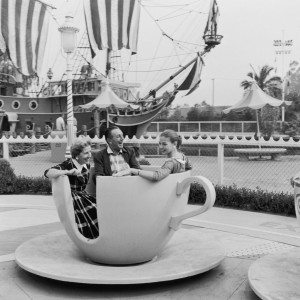WSJ Historically Speaking: From Gladiators to Mickey Mouse: Disneyland Turns 60
Sixty years ago, on July 18, 1955, the “Happiest Place on Earth,” better known as Disneyland, opened to the public. But on that day, the former orange grove in Anaheim, Calif., was one of the most miserable places in America. A heat wave caused the park’s new asphalt to stick to people’s shoes. A gas leak forced parts of the site to close, a plumbers strike led to a water shortage, and lax security resulted in dangerous overcrowding.
Reviewing the $17.5 million theme park, a journalist wrote in a local newspaper, “Walt’s dream is a nightmare…a fiasco the like of which I cannot recall in 30 years of show life.”
Undeterred, Walt Disney added ever more attractions and innovations, transforming mass leisure from its violent origins in the ancient world to today’s amusement-park industry, with $12 billion of annual revenue in the U.S.
Though the ancient Greeks were among the first to build leisure spaces in the form of parks, gardens and gymnasiums, the Romans expanded the concept into a way of life. By the first century, most of Rome’s citizens were living in semi-idleness, while thousands of slaves and coloni—the equivalent of sharecroppers—toiled ceaselessly on their behalf.
The republican tradition of public sporting events (as part of military training) gave way to commercial spectacles of deadly combat—with slaves and professional gladiators taking the place of citizens. During the reign of Emperor Claudius (A.D. 41-54), 93 days a year were dedicated to public games; by A.D. 354 this had increased to 175 days. Rome’s bored citizens passed the empty hours by frequenting the Colosseum and its arcades—the first and only leisure park dedicated to mass murder.
The revival of the pleasure park during the Renaissance returned the concept to its Greek origins. The Italian nobility created lavish gardens with water displays, open-air theaters and exotic menageries that they occasionally showed off to the public. The fashion for conspicuous leisure soon spread to England, where the first commercial pleasure park, New Spring Garden, opened in 1661. About a century later, the 8-year-old Mozart performed his British debut there. By the 18th century, 64 gardens were operating in London alone.
Not to be outdone in their leisure gardens, the French in 1804 devised one of the first roller-coasters: a wooden construction similar to a sled on wheels called Les Montagnes Russes (the Russian Mountains). They soon added locking wheels, tracks and cables, creating the first modern-style stomach churner. In 1843 the Danes joined in with the Tivoli Gardens in Copenhagen, boasting rides, restaurants, concerts and fireworks. The place is still popular.
Across the Atlantic, after a century of puritanical disdain, America’s growing middle class discovered that it had both the disposable income and the desire to pay for quality leisure time. The rapid transit companies that transported people to work began taking them to specially built amusement parks on the edge of town.
The Chicago World’s Fair in 1893 did more than showcase the first Ferris wheel; its groundbreaking entertainment area, Midway Plaisance, inspired a host of imitators. Within 10 years, the U.S., and New York’s Coney Island in particular, had become the amusement-park capital of the world. The theme park also emerged—notably Paul Boyton’s 1895 Coney Island Sea Lion Park, with water slides and performing marine mammals.
It took the genius of Walt Disney, however, to find a way of selling to customers the one thing that money allegedly can’t buy: happiness.

